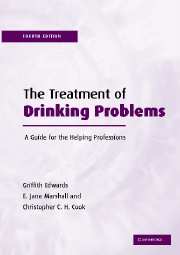Book contents
- Frontmatter
- Contents
- A note on the fourth edition
- Acknowledgements
- Introduction
- Part I Background to understanding
- Part II Screening, assessment and treatment
- 14 Case identification and screening
- 15 Assessment as the beginning of therapy
- 16 Withdrawal states and treatment of withdrawal
- 17 The basic work of treatment
- 18 Alcoholics Anonymous
- 19 Special techniques
- 20 Working towards normal drinking
- 21 When things go wrong, and putting them right
- 22 Treatment settings, professional roles and the organization of treatment services
- Author index
- Subject index
- References
20 - Working towards normal drinking
Published online by Cambridge University Press: 11 August 2009
- Frontmatter
- Contents
- A note on the fourth edition
- Acknowledgements
- Introduction
- Part I Background to understanding
- Part II Screening, assessment and treatment
- 14 Case identification and screening
- 15 Assessment as the beginning of therapy
- 16 Withdrawal states and treatment of withdrawal
- 17 The basic work of treatment
- 18 Alcoholics Anonymous
- 19 Special techniques
- 20 Working towards normal drinking
- 21 When things go wrong, and putting them right
- 22 Treatment settings, professional roles and the organization of treatment services
- Author index
- Subject index
- References
Summary
It is sensible to remember the varied nature of the population coming for help with drinking problems. Not everyone who turns for help because of drinking is suffering from alcohol dependence. With greater public understanding, people with earlier and lesser problems are increasingly asking for help and especially in the primary care or general hospital setting. To propose one exclusive goal for everyone, be it normal drinking or abstinence, is therefore not sensible (Heather and Robertson, 1981). We need, as always, to plan treatment in terms of flexible responses to multiple needs. To claim that no-one who has experienced trouble with drinking will ever be able to drink in a trouble-free way is mistaken (Sobell and Sobell, 1973, 1976, 1987). But it is unhelpful to make ‘normal drinking’ into a slogan or heedlessly to attack the position of Alcoholics Anonymous (AA). The probability of successful long-term, controlled drinking among the kind of patients who usually present to specialized centres is not high (Davies, 1962; Helzer et al., 1985; Edwards, 1985, 1994). A sense of balance is needed when considering these questions (Heather, 1995).
Much that was said in Chapter 17 about abstinence-oriented approaches is equally applicable to the normal drinking goal, for instance the relevance of the patient–therapist relationship, and those general points will not be repeated. The discussion of special techniques in Chapter 19 also bears on present considerations. In this chapter, the phrases ‘normal drinking’ and ‘controlled drinking’ are used synonymously.
Information
- Type
- Chapter
- Information
- The Treatment of Drinking ProblemsA Guide for the Helping Professions, pp. 343 - 355Publisher: Cambridge University PressPrint publication year: 2003
